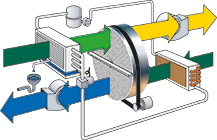 The Consorb principle is normally
The Consorb principle is normally
used at low regeneration
temperatures, e.g. if you have
surplus heat or when dehumidifying
very damp air. The Consorb principle
is also good when there is a large
difference in moisture content
between process and regeneration
air inlets.
Recusorb R has an internal heat
recycling. During the rotor’s
regeneration heat is absorbed,
and then recycled in the “purge
zone”, where incoming air is
preheated and partly dehumidified.
Energy consumption falls and the
dry air becomes both drier and
cooler compared to other sorption
dehumidifiers.
Recusorb DR has an internal heat
recycling with, one fan produces
both the dry airflow and the wet
airflow. This makes installation
simpler when there is a need for
overpressure in the room to be
dehumidified. This principle is also
suitable for very low dew points.
Aquasorb basically functions as
a Consorb, but the wet air flow is
condensed in an air-cooled condenser instead of being exhausted
out. No need for exhausting out wet
air from the dehumidified room. All
energy put into the unit stays also in
the room, which is good for drying
applications.
Econosorb combines a heat pump
with the sorption rotor in a unique
way, providing very low energy
consumption and a low dry air
temperature. Probably the most
energy efficient dehumidifier on
the market, with approximately 1/4
of the total energy consumption
of regular sorption dehumidifiers.
Econosorb has both condensation
and wet air flow.
Frigosorb is used in applications
where it is difficult to remove a wet
air flow. Thanks to the heat pump
function Frigosorb is very energy
efficient, using approximately 1/3
of the total energy consumption of
regular sorption dehumidifiers.






 Important – Wet Air Outlet duct arrangement for all desiccant dehumidifier installations
Important – Wet Air Outlet duct arrangement for all desiccant dehumidifier installations




